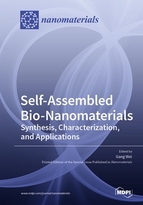Self-Assembled Bio-Nanomaterials: Synthesis, Characterization, and Applications
A special issue of Nanomaterials (ISSN 2079-4991).
Deadline for manuscript submissions: closed (28 February 2019) | Viewed by 44031
Special Issue Editor
2. Faculty of Production Engineering, University of Bremen, D-28359 Bremen, Germany
Interests: protein/peptide molecular self-assembly; synthesis and application of biomimetic nanomaterials; biological nanomaterials and biomedical engineering
Special Issues, Collections and Topics in MDPI journals
Special Issue Information
Dear Colleagues,
Supramolecular self-assembly is a simple but effective bottom-up technique for creating functional nanomaterials with novel structures and properties. Biomolecules, such as DNA, proteins, peptides, virus, enzymes, biopolymers, and others, have unique abilities to form hierarchical and ordered 1D, 2D, and 3D nanostructures and nanomaterials by molecular self-assembly in liquid, solid surface, and air–water interfaces. The self-assembled bio-nanomaterials have shown wide applications in the fields of biomedical engineering, tissue engineering, biosensors, nanotechnology, energy materials, and others. For example, the self-assembled peptide and protein bio-nanomaterials have been used to deliver drugs into the body system with specific targeting, and the biomineralized self-assembled nanomaterials have shown excellent potentials to repair old tissues and substitute natural structures and functions. By combining self-assembled bio-nanomaterials with other functional nanomaterials like nanoparticles, carbon nanotubes, and grapheme together, it is possible to create hybrid bio-nanomaterials with multi functions. Compared to inorganic nanomaterials, the formed hybrid bio-nanomaterials have high biocompatibility, self-assembly ability, physicochemical stability, and molecular recognition ability, therefore providing various potential applications in cell labelling, bioimaging, biosensors, and functional materials.
Great achievements have been made in this interesting field, it is still necessary and significant to investigate: (i) the synthesis of novel bio-nanomaterials by molecular self-assembly of various biomacromolecules and small molecules, (ii) the multi-characterizations of created biomaterials, and (iii) the potential applications of both pure self-assembled and hybrid bio-nanomaterials in drug delivery, regenerative medicine, tissue engineering, cell culture, bioimaging, sensors, functional materials, and others. Therefore, in this Special Issue of the journal Nanomaterials, we would like to gather contributions from you on these topics (not limited to them). Both original research and review papers are welcome.
We are looking forward to your great contributions to this Special Issue. Thanks and best regards,
Dr. Gang WeiGuest Editor
Manuscript Submission Information
Manuscripts should be submitted online at www.mdpi.com by registering and logging in to this website. Once you are registered, click here to go to the submission form. Manuscripts can be submitted until the deadline. All submissions that pass pre-check are peer-reviewed. Accepted papers will be published continuously in the journal (as soon as accepted) and will be listed together on the special issue website. Research articles, review articles as well as short communications are invited. For planned papers, a title and short abstract (about 100 words) can be sent to the Editorial Office for announcement on this website.
Submitted manuscripts should not have been published previously, nor be under consideration for publication elsewhere (except conference proceedings papers). All manuscripts are thoroughly refereed through a single-blind peer-review process. A guide for authors and other relevant information for submission of manuscripts is available on the Instructions for Authors page. Nanomaterials is an international peer-reviewed open access semimonthly journal published by MDPI.
Please visit the Instructions for Authors page before submitting a manuscript. The Article Processing Charge (APC) for publication in this open access journal is 2900 CHF (Swiss Francs). Submitted papers should be well formatted and use good English. Authors may use MDPI's English editing service prior to publication or during author revisions.
Keywords
- DNA
- Proteins
- Peptides
- Biopolymers
- Self-assembly Nanomaterials
- Hybrid materials
- Functional tailoring
- Nanotechnology
- Electrocatalysis
- Sensors
- Biosensors
- Tissue engineering
- Cell culture
- Drug delivery







